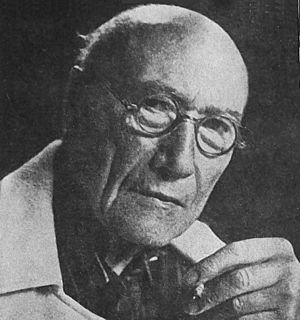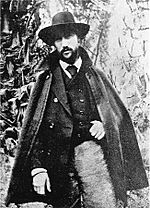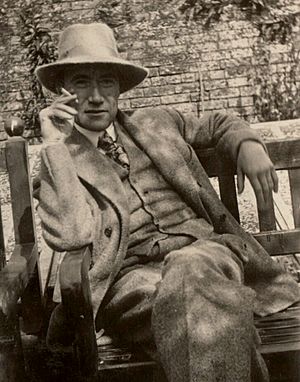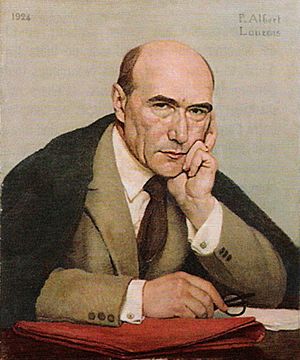André Gide facts for kids
Quick facts for kids
André Gide
|
|
|---|---|
 |
|
| Born | André Paul Guillaume Gide 22 November 1869 Paris, France |
| Died | 19 February 1951 (aged 81) Paris, France |
| Resting place | Cimetière de Cuverville, Cuverville, Seine-Maritime |
| Occupation | Novelist, essayist, dramatist |
| Education | Lycée Henri-IV |
| Notable works | The Immoralist Strait Is the Gate Les caves du Vatican (The Vatican Cellars; sometimes published in English under the title Lafcadio's Adventures) The Pastoral Symphony The Counterfeiters The Fruits of the Earth |
| Notable awards | Nobel Prize in Literature 1947 |
| Spouse | Madeleine Rondeaux Gide |
| Children | Catherine Gide |
| Signature | |
 |
|
André Paul Guillaume Gide ( 22 November 1869 – 19 February 1951) was a French author whose writings spanned a wide variety of styles and topics. He was awarded the 1947 Nobel Prize in Literature. Gide's career ranged from his beginnings in the symbolist movement, to criticising imperialism between the two World Wars. The author of more than fifty books, he was described in his obituary in The New York Times as "France's greatest contemporary man of letters" and "judged the greatest French writer of this century by the literary cognoscenti."
Contents
Early life
Gide was born in Paris on 22 November 1869, into a middle-class Protestant family. His father Jean Paul Guillaume Gide was a professor of law at University of Paris; he died in 1880, when the boy was eleven years old. His mother was Juliette Maria Rondeaux. His uncle was political economist Charles Gide. His paternal family traced its roots to Italy. The ancestral Guidos had moved to France and other western and northern European countries after converting to Protestantism during the 16th century, and facing persecution in Catholic Italy.
Gide was brought up in isolated conditions in Normandy. He became a prolific writer at an early age, publishing his first novel, The Notebooks of André Walter (French: Les Cahiers d'André Walter), in 1891, at the age of twenty-one.
In 1893 and 1894, Gide traveled in Northern Africa. There he came to accept his attraction to boys and youths.
Gide befriended Irish playwright Oscar Wilde in Paris, where the latter was in exile. In 1895 the two men met in Algiers. Wilde had the impression that he had introduced Gide to homosexuality, but Gide had already discovered this on his own.
The middle years
In 1895, after his mother's death, Gide married his cousin Madeleine Rondeaux, but the marriage remained unconsummated. In 1896, he was elected mayor of La Roque-Baignard, a commune in Normandy.
In 1901, Gide rented the property Maderia in St. Brélade's Bay and lived there while residing on the island of Jersey. This period, 1901–07, is commonly seen as a time of apathy and turmoil for him.
In 1908, Gide helped found the literary magazine Nouvelle Revue Française (The New French Review).
During The Great War, Gide visited England. One of his friends there was artist William Rothenstein. Rothenstein described Gide's visit to his Gloucestershire home in his autobiography:
André Gide was in England during the war. ... He came to stay with us for a time, and brought with him a young nephew, whose English was better than his own. The boy made friends with my son John, while Gide and I discussed everything under the sun. Once again I delighted in the range and subtlety of a Frenchman's intelligence; and I regretted my long severance from France. Nobody understood art more profoundly than Gide, no one's view of life was more penetrating. ...
Gide had a half satanic, half monk-like mien; he put one in mind of portraits of Baudelaire. Withal there was something exotic about him. He would appear in a red waistcoat, black velvet jacket and beige-coloured trousers and, in lieu of collar and tie, a loosely knotted scarf. ...
The heart of man held no secrets for Gide. There was little that he didn't understand, or discuss. He suffered, as I did, from the banishment of truth, one of the distressing symptoms of war. The Germans were not all black, and the Allies all white, for Gide.
Gide also became close friends with the critic Charles Du Bos. Together they were part of the Foyer Franco-Belge, in which capacity they worked to find employment, food and housing for Franco-Belgian refugees who arrived in Paris following the 1914 German invasion of Belgium. Their friendship later declined, due to Du Bos's perception that Gide had disavowed or betrayed his spiritual faith, in contrast to Du Bos's own return to faith.
In the 1920s, Gide became an inspiration for such writers as Albert Camus and Jean-Paul Sartre. In 1923, he published a book on Fyodor Dostoyevsky. But, when he defended homosexuality in the public edition of Corydon (1924), he received widespread condemnation. He later considered this his most important work.
In 1923, Gide sired a daughter, Catherine, by Elisabeth van Rysselberghe, a much younger woman. He had known her for a long time, as she was the daughter of his friends Maria Monnom and Théo van Rysselberghe, a Belgian neo-impressionist painter.
In 1924, he published an autobiography, If it Die... (French: Si le grain ne meurt). In the same year, he produced the first French-language editions of Joseph Conrad's Heart of Darkness and Lord Jim.
His legal wife, Madeleine Gide, died in 1938. Later he explored their unconsummated marriage in his memoir of Madeleine, Et nunc manet in te (And now it remains in you, published in English in the United States in 1952).
Africa
From July 1926 to May 1927, Gide traveled through the colony of French Equatorial Africa with his lover Marc Allégret. They went successively to Middle Congo (now the Republic of the Congo), Ubangi-Shari (now the Central African Republic), briefly to Chad and then to Cameroon before returning to France. He kept a journal, which he published as Travels in the Congo (French: Voyage au Congo) and Return from Chad (French: Retour du Tchad).
In this work, he criticized the behavior of French business interests in the Congo and inspired reform. In particular, he strongly criticized the Large Concessions regime (French: Régime des Grandes Concessions). The government had essentially conceded part of the colony to French companies, allowing them to exploit the area's natural resources, in particular rubber. He related that native workers were forced to leave their village for several weeks to collect rubber in the forest, and compared their exploitation by the companies to slavery. The book contributed to the growing anti-colonialism movements in France and helped thinkers to re-evaluate the effects of colonialism in Africa.
Political views and the Soviet Union
While sympathetic to Communism in the early 1930s, as were many intellectuals, after his 1936 journey to the USSR he supported the Anti-Stalinist left; during the 1940s he shifted towards more traditional values and repudiated Communism as an idea that breaks up with the traditions of the Christian civilization.
Gide contributed to the 1949 anthology The God that Failed. He couldn't write an essay because of his state of health, so the text was written by Enid Starkie, based on paraphrases of Return from the USSR, Afterthoughts, from a discussion held in Paris at l'Union pour la Verite in 1935, and from his Journal; the text was approved by Gide.
1930s and 1940s
In 1930 Gide published a book about the Blanche Monnier case called La Séquestrée de Poitiers, changing little but the names of the protagonists. Monnier was a young woman who was kept captive by her own mother for more than 25 years.
In 1939, Gide became the first living author to be published in the prestigious Bibliothèque de la Pléiade.
He left France for Africa in 1942 and lived in Tunis from December 1942 until it was re-taken by French, British and American forces in May 1943 and he was able to travel to Algiers where he stayed until the end of World War II. In 1947, he received the Nobel Prize in Literature "for his comprehensive and artistically significant writings, in which human problems and conditions have been presented with a fearless love of truth and keen psychological insight". He devoted much of his last years to publishing his Journal. Gide died in Paris on 19 February 1951.
Gide's life as a writer
André Gide's writings spanned many genres – "As a master of prose narrative, occasional dramatist and translator, literary critic, letter writer, essayist, and diarist, André Gide provided twentieth-century French literature with one of its most intriguing examples of the man of letters."
See also
 In Spanish: André Gide para niños
In Spanish: André Gide para niños




